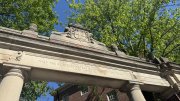The lights dim, and an excerpt of one of William Kentridge’s animated films begins. A parade of silhouette puppets marches from the left side of the screen to the right, seen in profile. Bowed over, most carry something on their backs: baskets, guns, bodies, shovels, children. A wordless voice half-sings, half-moans the melody of “What a Friend We Have in Jesus” to the accompaniment of an accordion in the background. Kentridge is a South African filmmaker whose work has been celebrated for its direct engagement with political and social issues. This film, Shadow Procession (1999), immediately calls to mind various historical displacements, exiles, and genocides, even as it avoids pinning the work to any specific time or place.
This is the first of the 2012 Charles Eliot Norton Lectures, in which a distinguished figure in the arts is chosen to give six lectures while spending a year in residence at Harvard. Past lecturers have included novelist Orhan Pamuk, pianist and conductor Daniel Barenboim, and many other notable creative figures.
Once the video finished, Kentridge cleared his throat and announced, “Let us begin in 360 B.C.” He then quoted, at length, the allegory of the cave from Plato’s Republic. As he worked to write a film capturing this story, he said, he struggled to find a setting in which to place the prisoners who can see nothing but the play of shadows and sunlight on the cave’s wall, and who when released can see the world outside the cave as a liberation into a higher reality, out of a half-aware deception. “While making the film, I could not find a destination that felt possible,” he said. “The procession could not end with a fête galante on the island of Cythera, like Watteau; it could not arrive at a civic state, as in David; nor could it arrive at a collective farm”—hence his choice to tell the story using shadows in an indeterminate setting.
Early in the hour, Kentridge spent some time reflecting on the lectures themselves. How to prepare for them, he wondered; “AVOID A 6-HOUR PARADE OF IGNORANCE” flashed on the projector screen above his head. Then, he said, “I listed every thought I ever had, and divided them by six. I wrote them on pieces of paper.”
The Norton Lectures are usually quite somber and serious, but Kentridge took great pleasure in leavening depth with wit and segueing from the silly to the sublime. Commenting self-reflexively on the habits of lecturers, he removed his glasses—honest-to-goodness pince-nez—and waved them through the air. “The adjustment of the sleeve,” he said, miming the actions from behind the podium, to laughter from his audience. “The removal of the watch. The double-handed tossing of the salad! The removal of the glasses for a frank look. The”—pause, wink—“almost-replacement of the glasses.”
Growing serious, he informed his listeners that each lecture would begin by focusing on one of his works, and then move “from images to ideas.” In this lecture, Kentridge recalled realizing that the Republic contained “a subtext of force”: to fulfill his duty to free and enlighten his comrades, the philosopher “must compel and coerce others to look, to see the light, to free the cave—and what if they refuse?…The light at the end of the tunnel, we are all too familiar, turns too quickly into an interrogator’s spotlight.” Read this way, the allegory reveals themes of “enlightenment, emancipation, and violence.”
He said he had devoted his own artistic career to fighting this sort of “forced looking”: “Fifty years in the studio have not been an attempt to answer the question, ‘Have you anything to say?’ but rather to disempower the question.”
To convince his listeners that we see what we see because we are told, he showed a remarkable video of a half-dozen pieces of torn black paper on a tabletop. His hands appeared onscreen, and almost magically configured the pieces into the shape of a horse. They then assembled the horse in a couple dozen permutations, which gradually became simpler and simpler until what we saw was nothing more than the memory of horseness, received—but which we couldn’t help but see.
Pace Plato, Kentridge disputed the idea that ideal forms outside us are strictly and uniquely real. Art, he said, is a project in “finding the mediated space between ‘it is’ and ‘it seems to be,’” and “illusion-making has an important place in the making of knowledge itself.”
Knowledge is subjective because individual interpretation is involved; Kentridge questioned the “godlike judgment” claimed by philosophers and judges. Claims to absolute, undiluted knowledge lead to an apparent right to power which all too often turns into the assertion of a right to wield violence. “Plato’s philosopher-king became Robespierre” and his slaves chained in the cave gradually transformed into slaves locked in lightless holds on the Middle Passage, he said. When faced with this totalitarian potential, he continued, it becomes all the more important to embrace the illusionism and doubleness of art: “It is in the very limitations of shadows that we learn…It is in the gap between the object and its representation that the image emerges, the gap we fill in—in the shift from the monochromatic shadow to the color of the object, from its flatness to depth and heft, allowing us to be neither prisoners in the cave, unable to comprehend or conceive, nor the all-seeing philosopher returning with all his certainty, but allowing us to inhabit the terrain between what we see on the wall and what we conjure back behind our retina.”
Kentridge’s lectures will continue on Tuesday, March 27, at 4 p.m. in Sanders Theatre, with “Drawing Lesson Two: A Brief History of Colonial Revolts.”
Spencer Lenfield ’12 is a former Berta Greenwald Ledecky fellow at Harvard Magazine.







